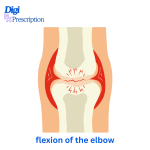
Whether you're lifting a dumbbell, scratching your head, or simply bringing a cup of coffee to your lips — you’re using elbow flexion. It’s one of the most basic yet essential movements your arm performs hundreds of times a day.
In this post, we’ll explore what elbow flexion is, the anatomy involved, common issues, and how to maintain flexibility and strength in this key joint.
What Is Elbow Flexion?
Elbow flexion is the movement that bends the arm at the elbow, decreasing the angle between the forearm and upper arm. In simpler terms, it’s when you bring your hand closer to your shoulder.
This action is part of everyday life and crucial for tasks like eating, grooming, typing, and lifting.
Anatomy Involved in Elbow Flexion
Several muscles, bones, and joints work together to create smooth flexion:
Bones:
-
Humerus – upper arm bone
-
Radius and Ulna – forearm bones
Main Muscles for Flexion:
-
Biceps Brachii – the most well-known muscle; also assists in forearm rotation.
-
Brachialis – lies beneath the biceps; the primary flexor of the elbow.
-
Brachioradialis – located in the forearm; assists in flexion, especially during lifting motions.
Nerves and Blood Supply:
-
The musculocutaneous nerve mainly controls elbow flexion.
-
How Elbow Flexion Works in Action
During elbow flexion:
-
The triceps brachii (located at the back of the arm) relaxes to allow the bending motion.
⚠️ Common Problems with Elbow Flexion
Several conditions can affect your ability to bend the elbow:
-
Tendonitis (e.g., biceps or triceps tendonitis)
-
Muscle strain or tears from overuse
-
Nerve impingement (e.g., ulnar or radial nerve issues)
-
Elbow fractures or dislocations
-
Arthritis (reducing joint mobility and causing pain)
-
Post-surgical stiffness or immobilization contracture
Exercises to Improve Elbow Flexion
If you’re recovering from an injury or just want to strengthen your elbow:
-
Bicep Curls – with dumbbells or resistance bands
-
Isometric Holds – hold the arm at a bent position without moving
-
Forearm stretches – to improve flexibility and range
-
Wall or table slides – gentle rehab exercises for limited mobility
Always consult a physiotherapist before starting rehab or if you're experiencing pain.
Tips to Protect Elbow Flexion
-
Warm up before upper-body workouts
-
Avoid overuse or repetitive stress
-
Maintain good posture and ergonomic workspaces
-
Stretch regularly to prevent tightness
-
Treat early signs of discomfort or inflammation promptly
Final Thoughts
Elbow flexion is a small but mighty movement that plays a major role in your daily life. Understanding how it works can help you protect this joint, recognize issues early, and improve your arm’s overall strength and flexibility.
Credible References
-
Anatomy, Bony Pelvis and Lower Limb, Elbow Joint
From [StatPearls – NCBI Bookshelf]
https://www.ncbi.nlm.nih.gov/books/NBK537066/ -
Mayo Clinic – Elbow Joint Overview
https://www.mayoclinic.org/ -
American Academy of Orthopaedic Surgeons (AAOS) – Elbow Anatomy
https://orthoinfo.aaos.org/en/diseases--conditions/elbow/ -
Cleveland Clinic – Elbow Tendon and Muscle Function
https://my.clevelandclinic.org/health/body/21784-elbow -
Physiopedia – Elbow Flexion & Range of Motion
https://www.physio-pedia.com/Elbow_Assessment
